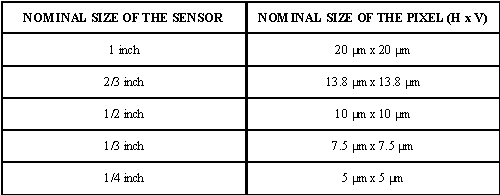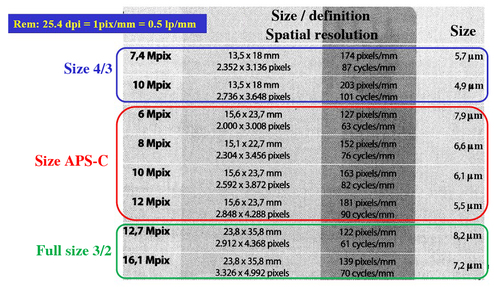
CCD chip size
Historically, vacuum tubes “vidicon” used for professional television applications were characterized by the diameter of the tube. In order to minimize the distortion and the non uniformities of the tube, the recommended size of the image was considerably smaller the the diameter of the complete tube. When CCDs replaced the tubes, the CCD industry maintained the image size but also continued to use the nomenclature of tubes. (Table 1).

Although each manufacturer provides a sensor and pixel size slightly different, the nominal sizes of 640 x 480 matrix are given in table 2. These pixels tend to be square. However, and in particular for interline transfer systems, approximately half of the pixel is dedicated to the vertical shielded transfer register. It means that the active width of the detector is half the width of the pixel. Thus, the active surface of a pixel is rectangular with interline transfer systems. For professionals of video, this asymmetry does not come as a source of significant disruption of the image quality. However, it is good to know this fact in scientific applications including the use of image correlation or stereophotogrammetry.
The decrease in optical format is linked to cost. The price of CCDs is principally determined by the manufacturing cost of wafers of semiconductors. When the size of the chip decreases, it is possible to place more matrices on a same wafer and this makes the rice of each individual chip decrease. The tendency to reduce the size of the chips will probably continue as long as optical and electrical performances of imaging systems do not change. However, smaller pixels reduce the size of the charge well. For a given luminous flux and aperture, the smallest sensors will have a lower sensitivity.

Smaller chips generate smaller cameras. However, in order to maintain the resolution, only the pixels can be small. Here, the compromise is relative to the size of the pixel, to the focal distance and to the total size of the chip.
The table 3 shows the most used sensors in general audience photography.
